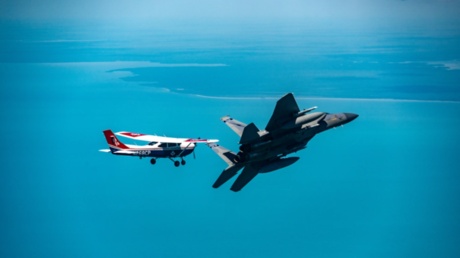In a series of security breaches, US fighter jets intercepted multiple civilian aircraft that violated restricted airspace over former President Donald Trump’s golf club in Bedminster, New Jersey, on Saturday. The North American Aerospace Defense Command (NORAD) confirmed that five separate incursions occurred, highlighting ongoing challenges in maintaining airspace security around high-profile locations.
The most significant incident took place at approximately 2:39 PM local time when a general aviation plane entered a Temporary Flight Restriction (TFR) zone, which had been activated due to Trump’s presence in the area. NORAD responded by scrambling a fighter aircraft, which executed a standard “headbutt maneuver” to alert the pilot and safely escort the aircraft out of the restricted zone.
Multiple Incidents in a Single Day
The interception was part of a broader alert response, as Saturday saw a total of five TFR violations in the Bedminster area. This included three breaches prior to the “headbutt” incident and one additional violation later in the day. Details about the aircraft or pilots involved were not disclosed by NORAD.
The command took to social media to remind pilots of their responsibilities.
“Pilots, a reminder to check FAA NOTAMs before you fly!”
NORAD posted on X, referring to Notice to Air Missions bulletins issued by the Federal Aviation Administration. The agency specifically highlighted FAA NOTAMs 1353, 1358, 2246, and 2247 as particularly relevant for flights near Bedminster.
Ensuring Airspace Security
The incidents underscore the importance of maintaining vigilance in airspace security, especially around areas frequented by high-profile individuals. NORAD emphasized that its layered air defense system, which includes radars, satellites, and fighter jets, remains active in detecting and responding to unauthorized incursions.
According to aviation experts, the repeated violations suggest a need for heightened awareness and compliance among pilots. John Smith, an aviation analyst, noted,
“These incidents highlight the critical need for pilots to be fully aware of their flight paths and the restrictions in place. The consequences of violating TFR zones can be severe, including interception, fines, or even license suspension.”
Background on Bedminster’s Airspace Restrictions
Trump has made Bedminster one of his primary residences since returning to office in January, prompting frequent designations of restricted airspace by the FAA whenever he is present. The TFRs are part of standard security protocols to ensure the safety of the president and others in the vicinity.
Historically, similar airspace restrictions have been implemented around other presidential residences and locations of national significance. The enforcement of these zones is crucial for national security, as unauthorized aircraft can pose significant risks.
Looking Forward
The recent incidents over Bedminster serve as a reminder of the ongoing challenges in airspace management and the importance of pilot education. As NORAD continues to monitor and respond to airspace violations, the aviation community is urged to remain vigilant and informed.
Moving forward, the FAA and NORAD are expected to continue their efforts to educate pilots on the importance of adhering to TFRs and the potential consequences of violations. Enhanced communication and awareness campaigns may be key in preventing future incursions and ensuring the safety of all airspace users.
 Scottish Couple’s Heartbreak: Tick Disease Claims Two Beloved Dogs
Scottish Couple’s Heartbreak: Tick Disease Claims Two Beloved Dogs Alan Titchmarsh Reveals Unexpected Wildlife Challenges in His Garden
Alan Titchmarsh Reveals Unexpected Wildlife Challenges in His Garden Texas Flash Flood Tragedy: Camp Mystic Death Toll Rises to 50
Texas Flash Flood Tragedy: Camp Mystic Death Toll Rises to 50 UK Parliament Approves Changes to Universal Credit and PIP Amid Reforms
UK Parliament Approves Changes to Universal Credit and PIP Amid Reforms UK Braces for Heatwave as Temperatures Soar to 35°C
UK Braces for Heatwave as Temperatures Soar to 35°C